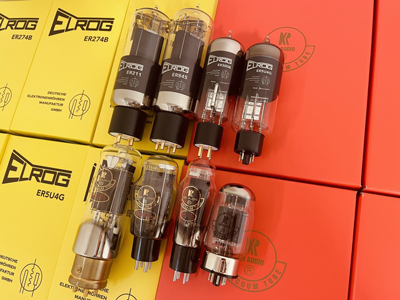


5 Vacuum Tube Manufacturers in 2024
This section provides an overview for vacuum tube as well as their applications and principles. Also, please take a look at the list of 5 vacuum tube manufacturers and their company rankings. Here are the top-ranked vacuum tube companies as of October, 2024: 1.Digivac, 2.Electro-Harmonix, 3.JJ Electronic.
Table of Contents
What Is a Vacuum Tube?

A vacuum tube, or electron tube, is a hollow device with a highly vacuumed interior and enclosed electrodes. It controls electrons through electric and magnetic fields to amplify, detect, rectify, oscillate, and modulate them.
Vacuum tubes consist of a container made of glass, metal, or ceramics. This container houses multiple electrodes in a vacuum or low-pressure environment, often with a small amount of rare gas or mercury.
The tubes are categorized based on their electrodes: bi-polar, tri-polar, quadrupolar, or pentode. Rectifier tubes, a type of 2-pole tube, are specifically used for rectification.
Uses of Vacuum Tubes
Vacuum tubes were once fundamental in electrical and electronic circuits for rectification, modulation, detection, and amplification. However, semiconductor elements have largely replaced them. Still, they are produced for broadcasting stations, the military, and particularly for audio and guitar amplifiers due to their excellent sound quality.
Special vacuum tubes like magnetrons continue to be important for generating microwaves in microwave ovens and radar.
Advanced applications include X-ray tubes, photomultiplier tubes (PMTs) for optical measurements, and image intensifiers for night vision.
Principle of Vacuum Tubes
Vacuum tubes operate on thermionic emission, where materials emit electrons when heated in a vacuum. In a bipolar vacuum tube, heating the filament emits electrons. Applying a positive potential to the plate attracts these electrons, allowing current to flow.
The triode vacuum tube has a grid between the plate and the filament. Adjusting the grid's potential controls the electron flow, enabling amplification.
Quadrupole, pentode, and beam tubes are evolved versions of the triode, offering enhanced performance.
Types of Vacuum Tubes
Vacuum tubes come in various types, each suited for specific purposes.
1. Audio and Guitar Vacuum Tubes
Primarily used in amplifiers for enhancing music and instrumental signals.
2. Transmitter Tubes
Crucial in transmitters for radio communication, broadcasting, and industrial high-frequency generators.
3. Cathode Ray Tubes (CRT)
Integral in devices like cathode-ray tubes for image display.
4. Magnetron
Key in microwave generation for radar and microwave ovens.
5. Imaging Tubes
Formerly used in TV cameras, now prevalent in nuclear reactor decommissioning due to radiation resistance.
6. Night Vision Tubes (Image Intensifiers)
Utilized in night vision devices and goggles.
7. X-ray Tubes
Employed in dental and industrial X-ray inspection tools.
List of 5 Vacuum Tube Manufacturers
*Including some distributors, etc.
Sort by Features
- Default
- Company Size: largest first
- Year Founded: oldest first
- Year Founded: earliest first
Sort by Area
- United States of America
- Slovakia
-
-

-
Digivac
Vacuum Tubes
Manufacturer Overview
DigiVac was founded in 1983 and is headquartered in Morganville, New Jersey. DigiVac engineers and manufactures measurement and control instruments and solutions designed to solve customer problems common in a medical vacuum, altitude simulation, transformer maintenance, HVAC, and other industries. In addition, DigiVac is ISO 9001:2015 certified. DigiVac’s product lineup includes large systems such as chillers, freezers, and ovens, as well as small components such as vacuum sensors. DigiVac also provides various calibration services, ODM and OEM design and manufacturing, and item customization options.
-
-
-
-

-
JJ Electronic
Vacuum tube
Manufacturer Overview
JJ Electronic, a company founded in 1993 and based in Čadca, Slovak Republic, is a manufacturer and supplier of vacuum tubes and electronic components. The company is known for producing tubes used in audio amplifiers, musical instruments, and professional audio equipment. The company provides a wide range of vacuum tubes, including preamp tubes, power tubes, and rectifier tubes. These products are utilized to cater to the needs of musicians, audio enthusiasts, and professionals in the audio industry. The company also offers customized customer services to meet clients' needs.
-
-
-
-

-
Electro-Harmonix
Vacuum Tubes
Manufacturer Overview
Electro-Harmonix, founded in 1968 and headquartered in New York City, is a manufacturer of audio effects and musical equipment. The company offers analog audio signal processing, digital delay, digital sampling, and polyphonic real-time processing. Its effects pedals are used by professional and amateur guitar players, bass players, keyboardists, producers, and studio engineers. Its iconic products are used worldwide and are utilized in recordings by The Police, Devo, Red Hot Chili Peppers, and Nirvana. The company also offers guitar amplifiers, vacuum tubes, Bluetooth headphones, and speakers.
-
-
-
-
-
PENTA LABORATORIES
vacuum tubes
-
-
-
-
-
TAKATSUKI ELECTRIC INDUSTRY CO.,LTD
vacuum tube
-
-
Vacuum Tube Manufacturer Ranking
*Including some distributors, etc.Ranking as of October 2024
Derivation Method| Rank | Company | Click Share |
|---|---|---|
| 1 | Digivac |
35.6%
|
| 2 | Electro-Harmonix |
19.7%
|
| 3 | JJ Electronic |
17.6%
|
| 4 | PENTA LABORATORIES |
14.1%
|
| 5 | TAKATSUKI ELECTRIC INDUSTRY CO.,LTD |
12.9%
|
Derivation Method
The ranking is calculated based on the click share within the vacuum tube page as of October 2024. Click share is defined as the total number of clicks for all companies during the period divided by the number of clicks for each company.Number of Employees
Newly Established Company
- JJ Electronic: 1993 (31 years ago)
- Digivac: 1983 (41 years ago)
- Electro-Harmonix: 1968 (56 years ago)
Company with a History
- Electro-Harmonix: 1968 (56 years ago)
- Digivac: 1983 (41 years ago)
- JJ Electronic: 1993 (31 years ago)
Vacuum Tube Manufacturers in United States
*Including some distributors, etc.
Global Distribution of Vacuum Tube Manufacturers by Country
*Including some distributors, etc.
| Country | Number of Companies | Share (%) |
|---|---|---|
 United States of America
United States of America
|
1 | 50.0% |
| Slovakia | 1 | 50.0% |